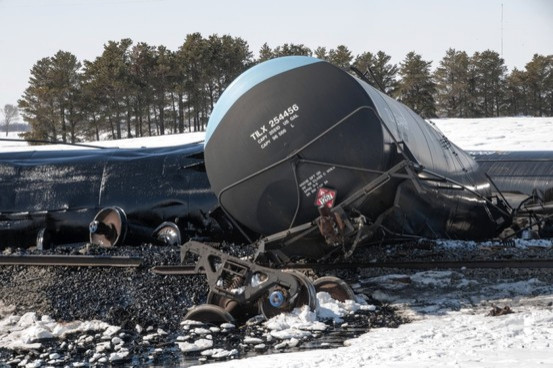What's The Safest Way To Transport Oil? US Transportation And State Departments Won't Say

Rail and pipeline oil transport companies are under high scrutiny following two significant spills in late March that revived questions about public safety and environmental protection. Yet getting an answer to the question of which is the safest way to transport oil is as messy and murky a process as the spills.
The U.S. Department of Transportation says it does not advocate one form of oil or hazardous material transport over the other, and when pressed on matters of which mode is safest, two different representatives each said, "we don't make that determination."
Weeks prior to either of the recent oil spill accidents involving a derailed train in Minnesota and a ruptured pipeline in Arkansas, DOT's two arms dedicated to rail and pipeline freight transport produced a joint fact sheet to accompany their raw tallies of incidents. The Federal Railroad Administration and Pipeline and Hazardous Materials Safety Administration's joint statement only said, "The safest mode of transportation between any two points is determined by a wide variety of factors." They listed service availability, regional topography, climate and environment, traffic patterns and population density as factors and added, "the U.S. Department of Transportation's role is to make sure that whatever mode is chosen by freight shippers, the products are transported safely and reliably."
The Department of Transportation says it provides only raw data of accidents and leaves conclusions up to independent analysts and statisticians. Environmental Research Consulting, which investigates ecological issues and specializes in oil spill analysis, conducted a risk assessment using federal data in 2006 that has been referenced ever since. Pipelines transport such a greater volume of crude and refined oils that they likewise spill the most and pose a much more serious risk, both now and in the future. But in terms of amount of oil spilled into waterways used by people (and difficult to clean up) per equal amounts shipped during the 24-year period covered in the study, the research found that trains are less efficient since they spill a greater portion of their units during transport.
The Minnesota and Arkansas spills raised public safety questions and also complicated the decision-making process for President Barack Obama as he remained undecided about permitting a new extension of the Keystone pipeline, known as the Keystone XL, from Canada. His decision will rely partially on information presented to him by the State Department in its March 1 Environmental Impact Statement on the Keystone XL.
The State Department's EIS also avoids making conclusions and does not make hard recommendations on whether the pipeline project, which is fiercely opposed by climate activsts, should move forward. It also fails to mention the higher spill incidence of rail transport. It only says that if the Keystone's XL extension is blocked, oil sands crude will still be able to reach markets by rail since trains carry more than 1 million barrels of oil per day over land.
"The draft Supplemental EIS concludes that approval or denial of the proposed Project is unlikely to have a substantial impact on the rate of development in the oil sands," it says, "or on the amount of heavy crude oil refined in the Gulf Coast area."
As energy companies turn to rail transport for areas not served by pipelines, oil spills on rail lines will likely rise, further emboldening environmentalists who advocate for a reduction in oil dependence. "No one has ever had a solar energy spill," said Daniel Souweine, campaign director with Forecast The Facts, a climate change awareness group. "Safety is a tough question because any type of oil transport is dangerous. It's a matter of picking your poison. What's your most favorite bad thing?"
© Copyright IBTimes 2024. All rights reserved.






















